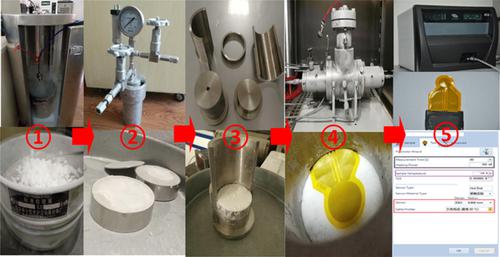当前位置:
X-MOL 学术
›
Int. J. Energy Res.
›
论文详情
Our official English website, www.x-mol.net, welcomes your feedback! (Note: you will need to create a separate account there.)
Study on the non‐in situ measurement method for hydrate thermal conductivity
International Journal of Energy Research ( IF 4.6 ) Pub Date : 2020-06-23 , DOI: 10.1002/er.5637 Shicai Sun 1 , Yuchao Hao 1 , Yuanjiang Sun 1 , Peng Li 1 , Changxing Zhang 1
International Journal of Energy Research ( IF 4.6 ) Pub Date : 2020-06-23 , DOI: 10.1002/er.5637 Shicai Sun 1 , Yuchao Hao 1 , Yuanjiang Sun 1 , Peng Li 1 , Changxing Zhang 1
Affiliation

|
A non‐in situ measurement method for gas hydrate thermal conductivity was established, including the sample preparation, sample transfer, sample loading, and thermal conductivity measurement. Taking tetrahydrofuran (THF) hydrate and methane hydrate as examples, the detailed process was investigated by many experiments. THF hydrate samples were prepared by the combined method of THF aqueous solution + temperature oscillation + aging, while methane hydrate samples were prepared by the combined method of compacted ice powder + temperature oscillation + supplementary gas + aging. The sample box, quick‐opening reactor, and sample mold were developed to improve the sample quality, shorten preparation time, and reduce exposure time. It was found that the time of sample transfer and loading can be controlled within 1 minute and 15 minutes for THF hydrate and methane hydrate, respectively. The thermal conductivities of THF hydrate and methane hydrate are 0.5200 ~ 0.5700 and 0.4803 ~ 0.6197 W•m−1•K−1 in the studied temperature range, respectively. The thermal conductivity of THF hydrate shows a positive dependence on temperature. The thermal conductivity of methane hydrate shows no dependence on temperature, but negative dependence on pressure. The errors of THF hydrate mainly come from the frost layer and micro airflow while the errors of methane hydrate mainly come from the ice film and micro gas flow. The precision, accuracy, and uncertainty of THF hydrate are 0.09% ~ 0.75%, 0.0450 ~ 0.0650 W•m−1•K−1 (absolute difference), 8.65% ~ 12.01% (relative error) and 0.00007 ~ 0.00017, respectively. Similarly, the precision, accuracy and uncertainty of methane hydrate are 0.04% ~ 5.98%, 0.005 ~ 0.0619 W•m−1•K−1(absolute difference), 1.02% ~ 12.12% (relative error) and 0.00016 ~ 0.00032, respectively. Based on the analysis, the established non‐in situ measurement technique in this work is completely feasible and can be used to measure the obtained naturally occurring samples.
中文翻译:

水合物热导率非原位测量方法的研究
建立了天然气水合物导热系数的非原位测量方法,包括样品制备,样品传输,样品加载和导热系数测量。以四氢呋喃(THF)水合物和甲烷水合物为例,通过许多实验研究了详细的过程。THF水合物样品是通过THF水溶液+温度振荡+老化的组合方法制备的,而甲烷水合物样品是通过压实冰粉+温度振荡+辅助气体+老化的组合方法制备的。开发了样品盒,快速打开的反应器和样品模具,以提高样品质量,缩短制备时间并减少暴露时间。已经发现,对于THF水合物和甲烷水合物,样品转移和加载的时间可以分别控制在1分钟和15分钟之内。THF水合物和甲烷水合物的热导率分别为0.5200〜0.5700和0.4803〜0.6197 W•m-1 •K -1分别在研究的温度范围内。THF水合物的热导率对温度呈正相关。甲烷水合物的导热系数与温度无关,而与压力无关。THF水合物的误差主要来自霜层和微气流,而甲烷水合物的误差主要来自冰膜和微气流。四氢呋喃水合物的精密度,准确度和不确定度分别为0.09%〜0.75%,0.0450〜0.0650 W•m -1 •K -1(绝对差),8.65%〜12.01%(相对误差)和0.00007〜0.00017。同样,甲烷水合物的精密度,准确度和不确定度分别为0.04%〜5.98%,0.005〜0.0619 W•m -1 •K-1(绝对差),1.02%〜12.12%(相对误差)和0.00016〜0.00032。根据分析,这项工作中建立的非原位测量技术是完全可行的,可用于测量获得的自然存在的样品。
更新日期:2020-06-23
中文翻译:

水合物热导率非原位测量方法的研究
建立了天然气水合物导热系数的非原位测量方法,包括样品制备,样品传输,样品加载和导热系数测量。以四氢呋喃(THF)水合物和甲烷水合物为例,通过许多实验研究了详细的过程。THF水合物样品是通过THF水溶液+温度振荡+老化的组合方法制备的,而甲烷水合物样品是通过压实冰粉+温度振荡+辅助气体+老化的组合方法制备的。开发了样品盒,快速打开的反应器和样品模具,以提高样品质量,缩短制备时间并减少暴露时间。已经发现,对于THF水合物和甲烷水合物,样品转移和加载的时间可以分别控制在1分钟和15分钟之内。THF水合物和甲烷水合物的热导率分别为0.5200〜0.5700和0.4803〜0.6197 W•m-1 •K -1分别在研究的温度范围内。THF水合物的热导率对温度呈正相关。甲烷水合物的导热系数与温度无关,而与压力无关。THF水合物的误差主要来自霜层和微气流,而甲烷水合物的误差主要来自冰膜和微气流。四氢呋喃水合物的精密度,准确度和不确定度分别为0.09%〜0.75%,0.0450〜0.0650 W•m -1 •K -1(绝对差),8.65%〜12.01%(相对误差)和0.00007〜0.00017。同样,甲烷水合物的精密度,准确度和不确定度分别为0.04%〜5.98%,0.005〜0.0619 W•m -1 •K-1(绝对差),1.02%〜12.12%(相对误差)和0.00016〜0.00032。根据分析,这项工作中建立的非原位测量技术是完全可行的,可用于测量获得的自然存在的样品。


























 京公网安备 11010802027423号
京公网安备 11010802027423号